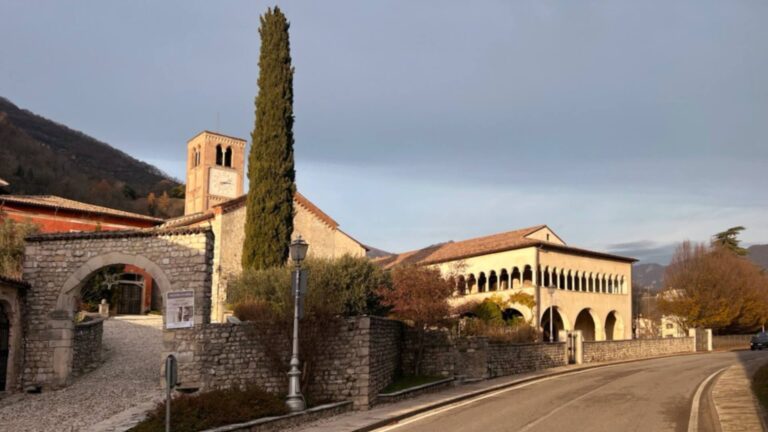ARTISTS’ ROADS
LE VIE DEGLI ARTISTI
watch the videos at the bottom of the page!
FOLLINA
Follina: The Cosmos in a Cloister
In a Cistercian monastery, the most important building is, of course, the church. It must be sober in decoration, yet firm in its structure. It must have three naves, and a presbytery with a square plan.
The second essential space is the cloister, the place around which the monks’ spiritual and communal life is organised.
If we study the plan of the Monastery of Fontenay, founded in 1118 by Saint Bernard of Clairvaux, or that of Chiaravalle Milanese, founded in 1135, the mother house of Follina, we find the same architectural layout.
The cloister is built against the south side of the church.
It is a quadrilateral. And the number four leads us directly to the Cosmos, and to the life of humankind: Four are the elements, the cardinal points, the winds, the seasons, the weeks of the month…
The area covered by the portico corresponds exactly to that of the central garden.
Like the church, it is aligned east to west, so that the first light of dawn illuminates the presbytery, the place of the altar. The monks begin their prayerful walk through the cloister on the eastern side.
They descend from their cells and walk. It is a peregrinatio, a spiritual journey, in stages, towards God.
Along the first side, they meditate on the contempt of the self. On the second, the contempt of the world.
Once this pars destruens is complete, they move to the pars construens. After humbling oneself, one must act and do good.
Here, the monks pray for the grace to love their neighbour. Fittingly, this side ends with a small door to the outside where one meets others in order to offer help.
The final side is dedicated to the contemplation of love for God. And it ends at the church entrance where that love finds fulfilment at the altar.
Even the garden is built with symbolic intent.
It is divided into four parts, centred around a fountain from which flows water, a symbol of life and of salvation.
Two beds once held plants mentioned in the Old Testament. The other two, those of the New Testament.
A fig tree and a cypress evoke the Garden of Eden and the Song of Songs.
An olive tree recalls Christ’s prayer in the Garden. And the palm, which rises again after fire, and of which no part is wasted, symbolises the Resurrection.
These four plants remind us that the culture at the roots of Christianity is Middle Eastern. Figs and dates are nourishing fruits typical of that region, carried in one’s satchel when crossing the desert.
The columns are each different from the next. They symbolise humanity: no one is the same as another. No one is perfect. But together, they form the beauty of humankind.
Follina was founded around 1145. An inscription tells us that this cloister was built in 1268, during the time of Abbot Tarino.
More than 750 years have passed. And this space still offers a drop of ancient spirituality.
A fragment of beauty from the Middle Ages but also a memory of a much older past. For the cloister is born of the peristyle, the open space around which the domus of ancient Rome was built. The very age in which Christ and the Apostles lived.
MORE EXPERIENCES!
SEGNI DEL SACRO:
- Un capitello a Refrontolo.
- Il campanile di Fregona.
- Il Santuario del Carmine a Miane.
- L’appartamento di Don Cumano nel Santuario di San Francesco di Paola a Revine.
MULTIMEDIAL MAP: “ARTISTS’ ROADS – LE VIE DEGLI ARTISTI- EN”!

